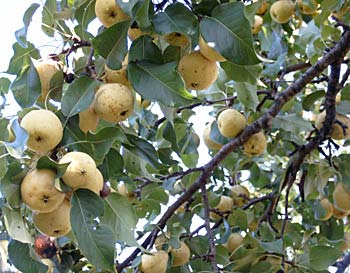Relatives
Pyrus ussuriensis Maxim. - Ussurian pear.
Taxonomic position.
Family Rosaceae Juss., genus Pyrus L.Synonyms.
Pyrus sinensis Lindl., P. communis auct. non. L.Morphology and biology.
Deciduous tree, up to 10 (15) m tall, with a broad pyramidal or oval crown. The bark on the trunk and larger branches is uneven, dark gray, while on younger branches the bark varies from grayish fulvous to almost black in color. Young branches are woolly, later glabrescent, pale brown. Leaves are 3.5-7.5 cm long and 3.5-6 cm wide, roundly or broadly ovate, with an abruptly acuminate, elongated tip and a cordate or roundish base, sharply serrated on the edges, bare and glossy above, while below younger leaves are slightly pubescent and later become bare. Flowers, 3-4 cm in diameter, are assembled into inflorescences, each containing 5-7 (9) flowers. Sepals are broadly triangular, drawn back at the tip, pubescent above; usually they remain on the tree for a long time after fruiting. Petals are white, corrugate. Fruits are globular-pyriform, obtusely conical or almost globular, up to 1.4-5 (7) cm in diameter, yellowish or yellowish green with tiny white specks, sometimes with rusty spots, set on a short stalk. Pulp is juicy, with pleasant flavor, sour-sweet, astringent, with a large number of seeds. Demonstrates high frost-resistance, but is very susceptible to diseases, especially the eastern strain of pear scab. Entomophilous. Ornito- and zoochore. Propagated by seeds, layers, root and softwood cuttings. Blossoms in May prior to the opening of leaves; bears fruit in September. 2n=34.Distribution.
Occurs in the Russian Far East (Maritime Territory, Amur basin), China (northeastern part), and Korea.Ecology.
Mesophyte. Grows individually or in small groups within cedar-broadleaved, broadleaved and mixed forests along river valleys and on river terraces in the lower mountain belt. Ascends the mountains as high as 1,100-1,300 m above sea level.Utilization and economic value.
Food (fruit), melliferous, ornamental. Long-domesticated species. Cultivars are grown within the species distribution area. Being frost-resistant, it is widely utilized in breeding programs in the northern regions of Russia, Canada and the U.S., where it also serves as a basic seedling stock for pear. Depending on their flavor, fruits are consumed fresh or dried and are used to prepare compotes and beverages. Wood is used to make souvenir craftwork articles.References:
Brezhnev D.D., Korovina O.N. 1981. Wild relatives of cultivated plants in the flora of the USSR. Leningrad: Kolos, p. 198-199 (in Russian).Likhonos F.D., Tuz A.S., Lobachev A.Y. 1983. Cultivated flora of the USSR. Pome fruit trees (apple, pear and quince). Vol. 14. Moscow: Kolos, pp. 150-151 (in Russian).
Maleyev V.P. 1939. Pear - Pyrus L. Flora of the USSR. Vol. 9. Moscow/Leningrad: Publishing House of the USSR Academy of Sciences, pp. 341-342 (in Russian).
Sokolov S.I., Svjaseva O.A., Kubli V.A. 1980. Areas of distribution of trees and shrubs in the USSR. Vol. 2. Leningrad: Nauka, p. 59 (in Russian).


